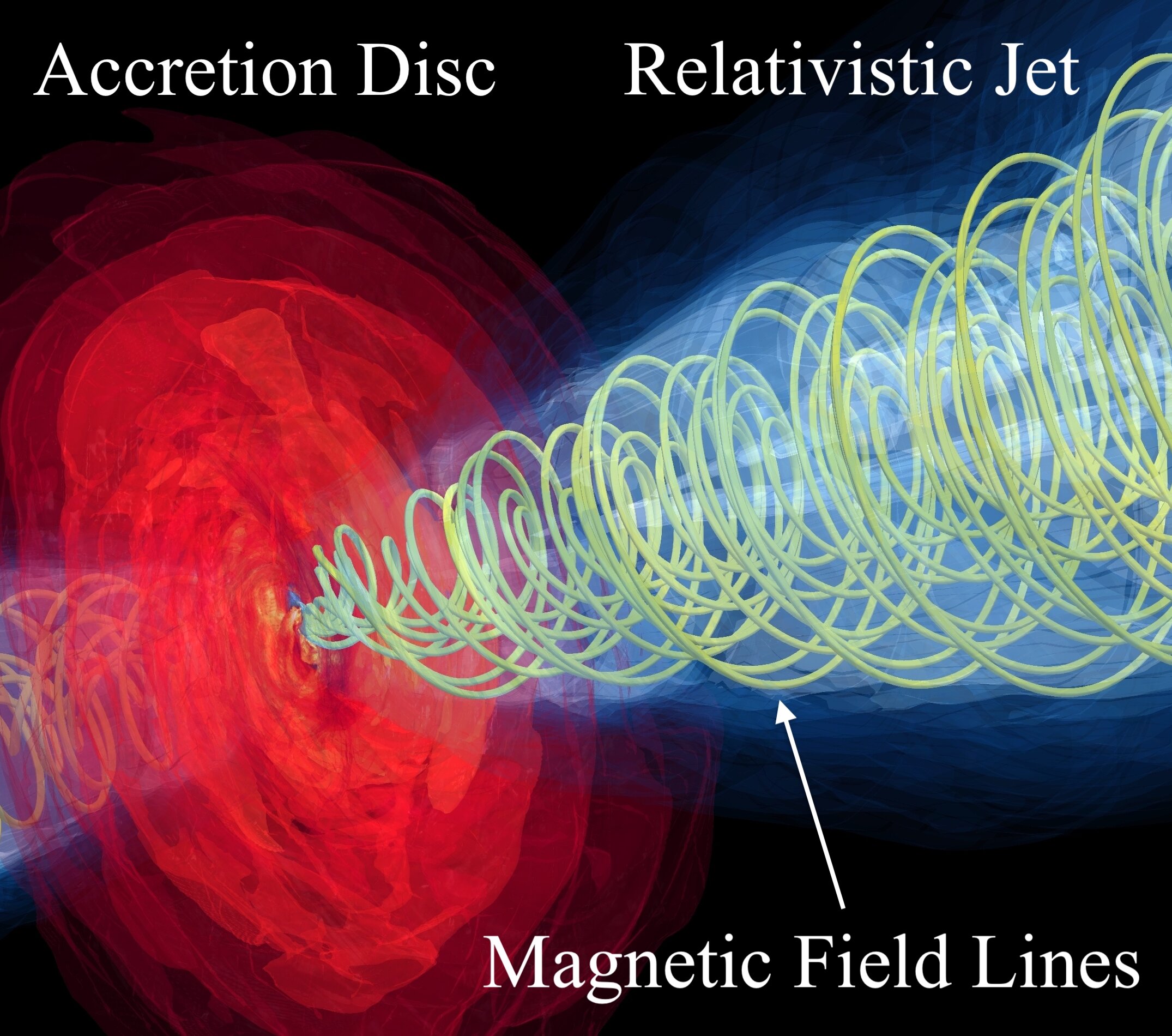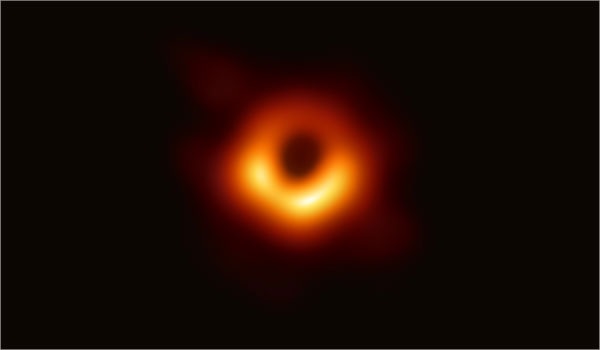From Goethe University [Goethe-Universität Frankfurt am Main](DE)
via

Along the magnetic field lines, the particles are accelerated so efficiently that they form a jet out to scales of 6000 light years in the case of M87. Credit: Alejandro Cruz-Osorio, Goethe University Frankfurt.
The galaxy Messier 87 (M87) is located 55 million light years away from Earth in the Virgo constellation. It is a giant galaxy with 12,000 globular clusters, making the Milky Way’s 200 globular clusters appear modest in comparison. A black hole of six and a half billion sun masses is harbored at the center of M87. It is the first black hole for which an image exists, created in 2019 by the international research collaboration Event Horizon Telescope.
 Messier 87*, The first image of the event horizon of a black hole. This is the supermassive black hole at the center of the galaxy Messier 87. Image via The Event Horizon Telescope Collaboration released on 10 April 2019 via National Science Foundation(US).
Messier 87*, The first image of the event horizon of a black hole. This is the supermassive black hole at the center of the galaxy Messier 87. Image via The Event Horizon Telescope Collaboration released on 10 April 2019 via National Science Foundation(US).

This black hole Messier 87* shoots a jet of plasma at near the speed of light, a so-called relativistic jet, on a scale of 6,000 light years. The tremendous energy needed to power this jet probably originates from the gravitational pull of the black hole, but how a jet like this comes about and what keeps it stable across the enormous distance is not yet fully understood.
Messier 87* attracts matter that rotates in a disc in ever smaller orbits until it is swallowed by the black hole. The jet is launched from the center of the accretion disc surrounding Messier 87, and theoretical physicists at Goethe University, together with scientists from Europe, USA and China, have now modeled this region in great detail.
They used highly sophisticated three-dimensional supercomputer simulations that use the staggering amount of a million CPU hours per simulation and had to simultaneously solve the equations of general relativity by Albert Einstein, the equations of electromagnetism by James Maxwell, and the equations of fluid dynamics by Leonhard Euler.
The result was a model in which the values calculated for the temperatures, the matter densities and the magnetic fields correspond remarkably well with what deduced from the astronomical observations. On this basis, scientists were able to track the complex motion of photons in the curved spacetime of the innermost region of the jet and translate this into radio images. They were then able to compare these computer modeled images with the observations made using numerous radio telescopes and satellites over the past three decades.
Dr. Alejandro Cruz-Osorio, lead author of the study, comments that “our theoretical model of the electromagnetic emission and of the jet morphology of Messier 87* matches surprisingly well with the observations in the radio, optical and infrared spectra. This tells us that the supermassive black hole Messier 87* is probably highly rotating and that the plasma is strongly magnetized in the jet, accelerating particles out to scales of thousands of light years.”
Professor Luciano Rezzolla, Institute for Theoretical Physics at Goethe University Frankfurt, remarks that “the fact that the images we calculated are so close to the astronomical observations is another important confirmation that Einstein’s theory of general relativity is the most precise and natural explanation for the existence of supermassive black holes in the center of galaxies. While there is still room for alternative explanations, the findings of our study have made this room much smaller.”
The findings were published in Nature Astronomy.
See the full article here.
five-ways-keep-your-child-safe-school-shootings
Please help promote STEM in your local schools.
Goethe University[Goethe-Universität Frankfurt am Main](DE) is a university located in Frankfurt am Main, Germany. It was founded in 1914 as a citizens’ university, which means it was founded and funded by the wealthy and active liberal citizenry of Frankfurt. The original name was Universität Frankfurt am Main. In 1932, the university’s name was extended in honour of one of the most famous native sons of Frankfurt, the poet, philosopher and writer/dramatist Johann Wolfgang von Goethe. The university currently has around 45,000 students, distributed across four major campuses within the city.
The university celebrated its 100th anniversary in 2014. The first female president of the university, Birgitta Wolff, was sworn into office in 2015, and was succeeded by Enrico Schleiff in 2021. 20 Nobel Prize winners have been affiliated with the university, including Max von Laue and Max Born. The university is also affiliated with 18 winners of the Gottfried Wilhelm Leibniz Prize.
Goethe University is part of the IT cluster Rhine-Main-Neckar. The Johannes Gutenberg University Mainz [Johannes Gutenberg-Universität Mainz] (DE), the Goethe University Frankfurt and The Technical University of Darmstadt [Technische Universität Darmstadt] (DE) together form the Rhine-Main-Universities (RMU).
Organization
Campus Westend
University Library at Campus Westend
The university consists of 16 faculties. Ordered by their sorting number, these are:
01. Rechtswissenschaft (Law)
02. Wirtschaftswissenschaften (Economics and Business Administration)
03. Gesellschaftswissenschaften (Social Sciences)
04. Erziehungswissenschaften (Educational Sciences)
05. Psychologie und Sportwissenschaften (Psychology and Sports Sciences)
06. Evangelische Theologie (Protestant Theology)
07. Katholische Theologie (Roman Catholic Theology)
08. Philosophie und Geschichtswissenschaften (Philosophy and History)
09. Sprach- und Kulturwissenschaften (Faculty of Linguistics, Cultures, and Arts)
10. Neuere Philologien (Modern Languages)
11. Geowissenschaften/Geographie (Geosciences and Geography)
12. Informatik und Mathematik (Computer Science and Mathematics)
13. Physik (Physics)
14. Biochemie, Chemie und Pharmazie (Biochemistry, Chemistry and Pharmacy)
15. Biowissenschaften (Biological Sciences)
16. Medizin (Medical Science)
In addition, there are several co-located research institutes of the Max Planck Society:
Max Planck Institute of Biophysics
Max Planck Institute for Brain Research
Max Planck Institute for European Legal History



